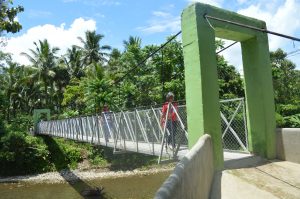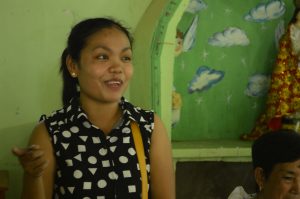
In a barangay only accessible by foot, residents have learned to adapt to whatever resources are available to get by.
For several years, the residents of Brgy. Remedios I in Mauban, Quezon Province have learned to set aside their fears of crossing two wooden hanging bridges to get to and from their barangay. School children, on the other hand, suffered from attending classes in their cramped barangay hall.
Despite their dreams to change the situation, progress seems to be far from reach.
However, looking at Brgy. Remedios I today, the fears and suffering of the residents are replaced with high hopes and dreams for the future.
This, according to them, is made possible by the countless opportunities that came to their community.
Identifying the needs of the community
Soledad Ureta, the former barangay captain of Remedios I, shared that the residents, in a barangay assembly, have agreed that the most pressing concerns of their community are the lack of classrooms for their elementary school and the stability of their hanging bridges, which provide primary access to their barangay.
In 2014, the residents had the opportunity to address these problems when the Department of Social Welfare and Development’s (DSWD) Kapit Bisig Laban sa Kahirapan—Comprehensive and Integrated Delivery of Social Services (Kalahi-CIDSS) came to their community.
In the Kalahi-CIDSS, the residents are involved in the local development process from the identification of their pressing needs up to the planning, implementation, operations and maintenance of the projects.
“Gusto talaga naming magkaroon ng dagdag classrooms para sa mga bata pero masyadong mahal ang pondo na kailangan para rito. Kaya pinili namin ang proyektong hanging bridge dito sa aming barangay,” said Soledad, who acted as the head of the volunteers during its implementation.
Improving access in the community
Reaby Oliveros, also a Kalahi-CIDSS volunteer, described their wooden hanging bridge as a threat to the safety of the residents not only of their barangay but also of their neighboring barangays who use the same bridge to get to the town proper.
“Yung tulay namin ay dating marupok at gawa lamang sa kahoy. Delikado talaga ito lalo na sa mga bata. Dahil sa tulay na pinagtulungan naming gawin, madami ang nakikinabang. Wala na kaming agam-agam sa tuwing tumatawid kami sa tulay,” shared Reaby, who is a beneficiary of the Pantawid Pamilyang Pilipino Program, another program of the DSWD that provides conditional cash grants in support for the educational and health needs of children zero to 18 years old.
Reaby recalled how hard it was to work as part of the Project Preparation Team in charge of the proposals and documents of the project especially that she had a newborn child during the project implementation.
“Kahit mahirap, nagsakripisyo ako. Naalala ko na tinuturo sa amin sa Pantawid Pamilya na ano ang magiging silbi mo sa barangay kung hindi ka tutulong,” Reaby shared with pride.
In the Pantawid Pamilya, parent-grantees are also encouraged to actively participate in their community which is being strengthened through discussions in Family Development Sessions (FDS).
The FDS is a monthly gathering of parent-grantees that teaches them on various family enhancement topics including strengthening marital relations, child’s rights, financial management and disaster preparedness among others.
In March 2016, the PhP461,046-worth hanging bridge project has been completed and is now being used even by the residents of Brgy. Remedios II, their neighboring barangay.

More blessings for Remedios I
The realization of the cable bridge in the barangay has been a big achievement for the residents; however, it also meant the end of their dreams of new classrooms for their children.
“Napakaswerte namin at tuwang-tuwa kami noong nalaman namin na popondohan din ang school building dito sa aming barangay,” said Soledad.
The DSWD has submitted the school building proposal of the residents for possible funding. In 2015, the project was funded by the Department of Foreign Affairs and Trade of the Australian Government, a development partner of the DSWD for closing gaps in education facilities in poor communities.
The project was provided a grant of PhP2.4 million which was spent for the construction of a three-classroom school building complete with chairs, furniture and comfort rooms for the students.
“Parang rags to riches ang k’wento ng school namin dito. Mula sa pagsisiksikan ng mga bata sa barangay hall, nagkaroon kami ng school na may tatlong classrooms. Ngayong pasukan, dahil sa Kalahi-CIDSS, mayroon na kaming anim na classrooms na sapat para hindi na maging multi-grade ang mga klase,” shared Liza Diasanta, a teacher in the elementary school.
She also added that having enough classrooms for their pupils will make both the learning for the students and the teaching for the teachers easier.
“Parang ito na ‘yung simula ng pag-abot ng pangarap naming mga guro at ng kanilang mga magulang para sa mga bata,” said Liza.

Only moving forward
The implementation of the two projects in the barangay, according to the residents, have brought them together and made their dreams closer.
Marilou Delos Santos, another Pantawid Pamilya beneficiary who volunteered for the Kalahi-CIDSS projects, shared that they are working together to take care of these blessings.
“Tumutulong ang mga beneficiaries ng Pantawid Pamilya sa maintenance ng mga proyekto. Mayroon kaming monthly cleanup drives at tumutulong din kami sa Brigada Eskwela sa school dahil kami rin naman ang nakikinabang dito at ito rin ang maisusukli namin sa pagtulong sa amin ng programa,” shared Marilou.
To date, there are 50 household-beneficiaries of the Pantawid Pamilya in the barangay.
Today, the residents of Brgy. Remedios I have only gratitude towards the progress they are experiencing in their community. And what makes them happier is that they know that they have all been a part of realizing this change.#
